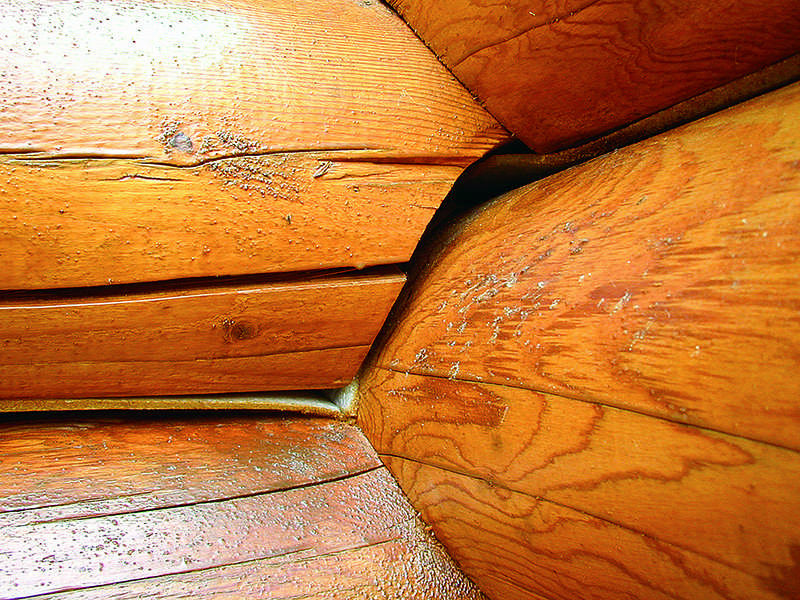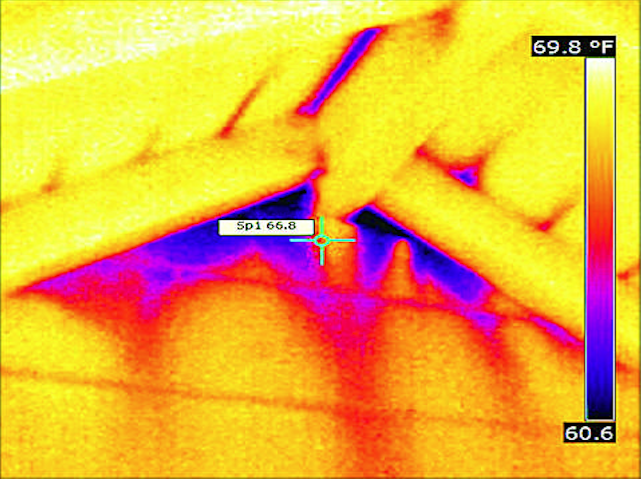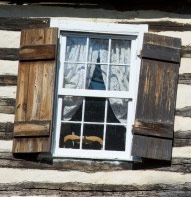
In new log home construction, builders are continuously adapting their practices to meet the latest energy code requirements and ensure that the homes they build comply. But what about existing log homes?
If you’ve been in your home for five or more years, chances are the energy codes have changed in your area. This isn’t that big of a deal, unless you are considering a renovation or addition, and then technically you, too, must comply with the current code for the affected area.
In a full-log home, adding wall insulation isn’t an option without destroying the beauty of your log walls (and, thanks to the insulating properties of thermal mass, it’s probably not even necessary.) If you want to boost your home’s energy performance, there are a variety of ways to do so and keep your logs intact.
Here are nine of our favorites.
Get an Energy Audit

A thermography energy scan (above) shows where a log home’s heat loss is concentrated. By using this visual aid, you can pinpoint problem areas accurately and seal them up.
Okay, so this one isn’t a retrofit per se, but it’s an essential first step, because before you can make your home more energy efficient, you need to know where you stand. An energy audit can show that. Hire the services of a certified RESNET (Residential Energy Services Network) or HERS (Home Energy Rating System) auditor to conduct an energy audit to assess your log home’s performance and pinpoint the areas that need attention. They can do this in a number of ways.
One of the most common is a blower door test, which pulls air out of a house with a powerful fan attached to an exterior-door frame, then identifies places where air seeps back inside. Costing roughly $150-300, it’s a simple, low-cost way to determine your home’s air-tightness. Thermography is another option to measure energy loss, and works by scaning your home’s surface temperatures with infrared video and still cameras.
Areas that appear red to purple on the scan indicate where heat is escaping. A thermography scan is typically based on square footage, but, on average, costs $200-400. For the most accurate results, an auditor may suggest you do it in conjunction with a blower door test. Once you measure your home’s energy-loss hotspots, the findings will help prioritize which upgrades you will need.
Treat the Leaks
According to the DOE, space heating makes up 42 percent of your annual home energy consumption; cooling is 6 percent. If it leaks, that’s money flying right out of the window. New log homes are commonly completed as weather-tight shells before the interior work is done, which is a perfect time to run a blower door test.
Sealing a log home is not much different than preparing any type of house for air tight performance. If you’ve been in your home a while, it’s a good idea to see how your sealants are holding up. If your log walls were built and maintained properly, the most common places you’ll find leakage are around window and door frames and the attic, if you have one. Of course the best way to treat leaks is to prevent them.
The National Association of Home Builders’ Log and Timber Homes Council wrote “The Prevention of Air and Water Infiltration: A Systems Approach” to help. You can download it in the “library” section of its website, loghomes.org.
Increase Insulation
Heat rises; so there’s no question that the roof is the first area where an insulation upgrade may be needed. However, there’s a reasonable limit to how much insulation you can add before there isn’t a return on your investment.
According to log home technical specialist Rob Pickett, the point of diminishing returns is an R-value of 60. That means your insulation investment up to that point has a direct correlation to energy savings. Insulating beyond that point cannot be proven to increase those savings further.
Before making changes, check how your roof was built and insulated. Removing light fixtures in the ceiling and peeking into the cavity may provide some insight. Also, inspect second-story floors that are above an open area, such as a porch. Insufficient insulation under there could cause cold spots in the room above.
Seal Your Ducts
The Environmental Protection Agency estimates that roughly a fifth of the air from forced-air HVAC systems escapes through duct leaks. In fact, distribution losses are a target of current energy codes and efficiency programs. According to Rob, there is an easy test to see if your system is working properly.
Turn on the heat and go to the air register that’s farthest from the HVAC unit itself to see if the forced air is arriving. If not, you obviously have a problem, and it’s most likely a leak in the ductwork. Those lines should be sealed and insulated. Insulating the foundation stem walls of a basement or crawl space may also be a good long-term energy-saving investment.

Replace Old Windows
When it comes to energy loss, old drafty windows can be one of the biggest culprits. There have been incredible advances in window-glazing technologies in the past 10 to 15 years alone. And though window replacement can be pricey, it may be worth every penny.
According to the U.S. Environmental Protection Agency, ENERGY STAR-rated units can lower your household energy bills 7 to 15 percent. For maximum efficiency, look to products ranging from double or triple pane to low-E coatings or argon-gas filled units. Evaluate performance based on U-factors (the rate of heat loss in a window assembly), which is displayed on a label on each unit.
The National Fenestration Rating Council reports that high-performance double-pane windows can achieve U-factors of 0.30 or lower, and some triple-pane windows can even go as low as 0.15. When comparing U-factors, the lower the number the better the performance.
Add Storm Windows
When faced with multiple challenges to make an existing home more energy efficient, storm windows are more affordable than a full-blown window replacement and, according to Rob, may offer a better return on your overall investment. “Not only do they add a layer of insulating glass, they provide supplementary protection against water and air infiltration,” he says.
Install Energy-Efficient Doors
If improving energy performance is your goal, there’s one thing you should definitely avoid: hollow steel doors. A wood door, which has a solid core, is much more energy efficient and it’s a perfect log home complement. They aren’t cheap, but they will enhance both the look and comfort level of your home. If a wood door just isn’t in the budget, again, look to ENERGY STAR certified metal or fiberglass insulated doors.
Update Your HVAC
This one’s a no-brainer, right? But the key to success is to upgrade to an HVAC system that is properly sized for your home and right for your climate. Go too large and you will just be wasting your money; too small and the unit will run longer and work harder, negating any energy benefits it may have offered. If you live in a cooler region, Rob suggests a unit with a 90 percent or better efficiency rating. For warmer areas, a heat pump with a 15 SEER (Seasonal Energy Efficiency Ratio) will keep costs down. If you have sealed your log home to air-tight standards, Rob highly recommends an air-to-air heat exchanger as part of your overall HVAC solution. Exhaust fans, in combination with these units, provide a balanced approach to keeping the inside air cleaner and healthier.
Opt for High-Efficiency Water Heaters
If your shower takes a long time to heat up or you run out of hot water after you do the laundry, there could be a few factors at play. It may be that the water heater is located too far away from where you use hot water most frequently, like a shower. Pipes contain water when not in use and that cooled H2O needs to be forced out before the hot stuff can find its way to you. If your unit is in the basement and the shower is on the opposite side of the house on the second level, that could take a while and waste water, energy and time. Another offender might be that your hot water tank is insufficiently sized for your needs. Tankless, instant hot water heaters could be a solution. Thanks to the members of NAHB’s Log and Timber Homes Council for providing content to this article. For more information about the LTHC, visit loghomes.org.
For more tips on home maintenance through the seasons, visit loghome.com/easy-log-care.











